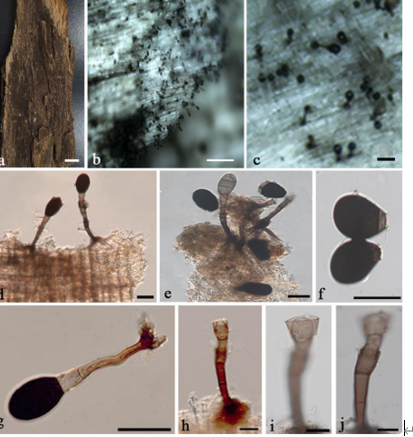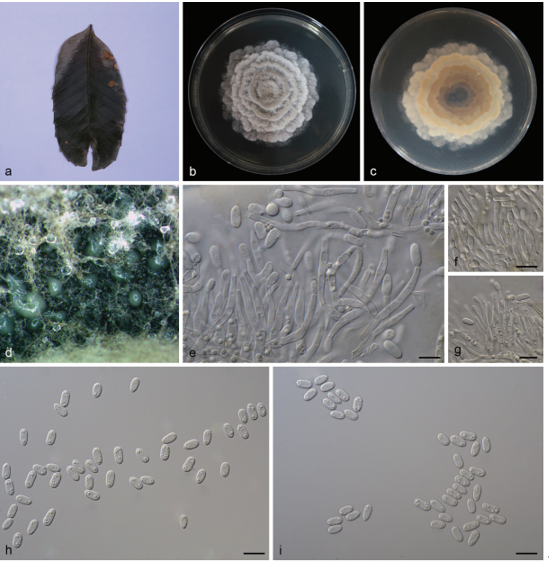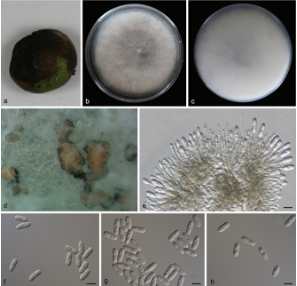Sporidesmium dulongense Z.L. Luo, K.D. Hyde & H.Y. Su, sp. nov. 2020
Index Fungorum number: IF555377; Facesoffungi number: FoF04924
Holotype: CHINA, Yunnan Province, saprobic on decaying wood submerged in Dulong River, May 2015, Z.L. Luo S-436 (HKAS 92659, holotype), ex-type living culture MFLUCC 17-0116.
Morphological description
Saprobic on submerged decaying wood. Sexual morph: Undetermined. Asexual morph: Colonies effuse on natural substrate, scattered, hairy, dark brown to black. Mycelium immersed, composed of septate, branched, brown, smooth hyphae. Conidiophores 88–124 μm (x̅ = 106 μm, SD = 18, n = 25), 5.5–7.5 μm (x̅ = 6.5 μm, SD = 1, n = 25), macronematous, mononematous, unbranched, erect, straight or flexuous, dark brown, septate, smooth. Conidiogenous cells monoblastic, holoblastic, terminal, determinate, dark brown, cylindrical. Conidia 50–58 μm (x = 54 μm, SD = 4, n = 30), 13–15 μm (x = 14 μm, SD = 1, n = 30), acrogenous, solitary, dry, lageniform, straight or slight curved, tapering and hyaline at apex, truncate at base, dark brown, septate, with sphaerical guttules in almost all cells, smooth-walled.
Habitat: on decaying wood submerged in Dulong River
Distribution: Yunnan Province, China.
GenBank Accession: TS MH795812, LS MH795817, rpb2 MH801190, tef1 MH801191
Notes: Sporidesmium dulongense is most similar to S. submersum in having unbranched, dark brown, septate conidiophores and acrogenous, solitary, pyriform, septate conidia with sphaerical guttules in almost all cells. However, S. dulongense differs from S. submersum by its longer conidiophores (88–124 μm vs. 59–72 μm) and lageniform conidia with a long hyaline apex. Phylogenetic analysis based on multi-genes also showed that they are distinct species in Sporidesmium.
Reference: Hyde KD1,2,3,4,5,6,7, NorphanphounC2,3,6,15,19, Maharachchikumbura SSN26 et al.

Sporidesmium dulongense (HKAS 92659, holotype). a Colonies on wood. b-d Conidiophore with conidia. e, f Conidiogenous cells. g-i Conidia. j Germinating conidium. Scale bars: b = 55 μm, c, d = 45 μm, e, h, j = 25 μm, f-g, i= 30 μm.









